-
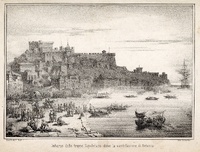
A mid-nineteenth-century lithograph depicting the Neapolitan retreat following the 1860 Battle of Milazzo between Giuseppe Garibaldi's troops and the Kingdom of the Two Sicilies.
-
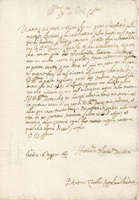
Transcripts, or simple copies, of legal documents from Italian archives pertaining to the locality of Media, or Medea.
-
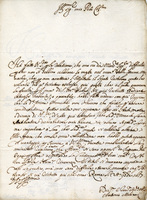
Transcripts, or simple copies, of legal documents from Italian archives pertaining to the locality of Media, or Medea.
-
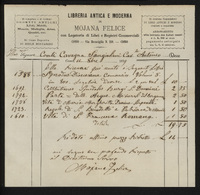
This receipt is for six books bought in 1879 for a total of fourteen lire after discount, signed by the bookseller with "profound respect, in devoted service." Two of the books listed on the receipt are duplicates in the collection, indicating perhaps that Cavagna did not keep track of his purchases, or simply could not pass up a good deal.
-
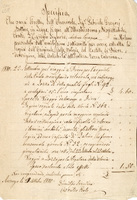
Much can be learned about Cavagna's collecting habits from items found in the books themselves. The receipt found in the manuscript "Notizie del castello di Pieve di Cadore" indicates that Cavagna may have commissioned transcriptions of much of his manuscript material from copyists who would travel to various archives in northern Italy; the receipt itemizes time spent traveling and copying the work.
-

Cavagna's family papers were not included in the sale to the University, but letters, postcards, and photographs in the nearly seven linear feet of ephemera in the collection give a small glimpse into his life. Photographs show the family outside their villa in Zelada, near Bereguardo in the province of Pavia.
-
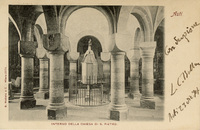
Cavagna's family papers were not included in the sale to the University, but letters, postcards, and photographs in the nearly seven linear feet of ephemera in the collection give a small glimpse into his life. Postcards depicting churches in Asti from Cavagna's future son-in-law Luigi Cesare Bollea are addressed to the entire family, including extra ones to Antonia, whom he would marry.
-
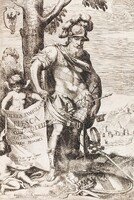
Federici, born around 1570, was from a well-to-do Ligurian family with deep ties to the Genoese ruling class. Rising through the ranks of civic offices, Federici became a Senator of the Republic of Genoa in 1646. His writings on Genoese antiquities earned him commissions from the government to write official histories of Genoa, including the origins and characteristics of its noble families. His encomiastic final work, Della famiglia Fiesca, was considered by many to be subversive, as only a few years prior Giovanni Luigi Fieschi had conspired against the Doria family that ruled Genoa at the time.
-
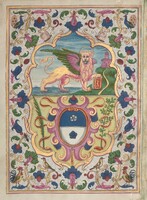
Barbuo's work is a summary of the lives of the Visconti and Sforza dukes of Milan, who were very prominent patrons of Renaissance art and architecture. The Visconti dynasty ruled Milan for nearly two centuries until the death of Filippo Maria in 1447, who had no male heir. Francesco I Sforza, Filippo Maria's "condottiero" and son-in-law, took over and began the reign of the House of Sforza, which lasted until 1535. The book gives a short biography of each duke, paired with an impressive engraved portrait. As in the manuscript Famiglie nobili di Venezia in the exhibit, this volume also bears the traces of the Mocenigo family, with an illuminated parchment leaf pasted opposite the title page. The miniature was likely made in the nineteenth century in the style of medieval illumination. Above the Mocenigo arms is the Lion of St. Mark, the symbol of Venice.
-
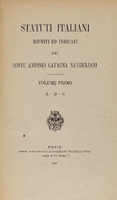
Cavagna was a prolific author and published widely on art and architecture, local history, biographies and memorial works, and family histories and genealogies. He also published bibliographies of his collections, although most were unfinished at his death. His Statuti Italiani, published in Pavia in 1907, records thousands of statues of Italian cities and municipalities held in his collection, A-M only. His nearly 160 publications and journal articles, many relating to his activities as a public official, are detailed in Bollea's In Memoria.
-

This memorial volume was published one year after Cavagna's death by his son-in-law. It provides a detailed account of his life, military service, activities as a public official, membership in societies and other institutions, and honorifics received from military and chivalric orders. Cavagna's time fighting for unification in 1866 is reproduced in facsimiles of letters to his father, and the histories of both the Cavagna and Sangiuliani families are detailed in genealogical tables.
-
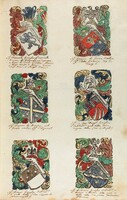
There are scrapbook elements in this collection of coats of arms of noble families of Ferrara. Each coat of arms includes a blank shield, floriate border, and helmet, likely produced from a limited set of woodblock templates. To this base, each family's crest is added above the helmet. The escutcheon may be drawn in a colored by hand, or finished with woodcut overlays. More hand coloring completes the coat of arms. The family name is inscribed below, sometimes with brief descriptions. Some shields remain blank, perhaps from lack of information. In 1689 another edition of this work was published: this time, printed entirely from woodcut, with no hand coloring or customization.
-

Coronelli (1650-1718) was a Franciscan friar, geographer, and prolific cartographer, both terrestrial and celestial. He was especially known for his ornate globes that graced many royal palaces. Coronelli's Atlante Veneto is considered the first comprehensive atlas produced in Italy and elevated the esteem of Italian cartography in Europe. Coronelli also put his considerable artistic skills to the study of heraldry, producing Blasone Veneto, first published in 1693. This diminutive volume begins with a general guide to the study of heraldry, followed by 78 coats of arms of the cities in the Veneto region and over 900 arms of the patrician families of Venice.
-
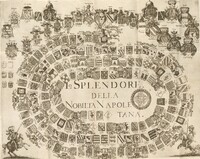
This "guioco d'arme" is a game in which players roll dice to advance along a track, loosely modeled on the game of the goose. The book contains the rules, with the engraved gameboard folded within. The purpose of the game is to help young nobles learn the names and coats of arms of the Neapolitan nobility, the ruling families, and the ranks of the government and church. The "way to honor" has two paths, either secular, ending with the king, or religious, ending with the pope. There are traps along the way: if you land on "Gerusalemme," the player has to recite "Dio lo vuole" and go on a pilgrimage (i.e., lose a turn).
-
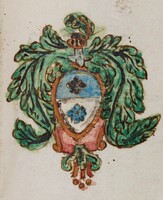
This miniscule manuscript measuring less than 10 cm, made some time after 1616, lists members of approximately 139 noble Venetian families. It is a working register of sorts: a typical entry lists the head of the household and his father's name, sometimes with names of his wife and children. While birth dates would be included, death dates might be added later, as they occurred. This manuscript was likely owned by a member of the Mocenigo family, as their coat of arms is hand colored on the first page. The Mocenigo family produced seven Doges of Venice—chief magistrate and leader of the Republic—over several centuries.
-
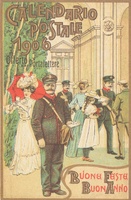
The postal service in Italy was consolidated under Napoleon, and following unification, underwent extensive reforms. In 1871 it began to distribute its illustrated postal calendar, in part as a public education initiative, reaching corners of the country where printed educational materials had not yet proliferated. The calendars, which present much of the same information as a typical almanac, were given as gifts by the "postini" to their customers around Christmas time. The colorful covers of each issue reflect aesthetic trends, such as art nouveau and art deco, and often present didactic messages, such as national pride in Italy's artistic and archaeological heritage.
-
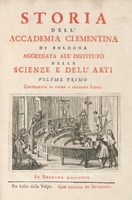
The engraved scene on the title page depicts a life drawing class in Bologna's Accademia Clementina, named after Pope Clement XI. Painter and art historian Giampietro Zanotti (1674-1765) helped found the academy in 1710, based on the model of Annibale Carracci's Accademia degli Incamminati. The Bolognese painting tradition emphasized life drawing from the nude, which was the basis of instruction at the school. The two-volume work is full of skilled engravings made by members of the academy, depicting putti practicing techniques of etching, sculpture, fresco painting, and measuring for scale.
-
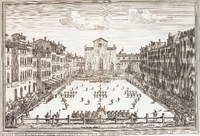
This work records the history of "calcio fiorentino," or Florentine kicking game. Combining elements of modern-day soccer, rugby, and wrestling, the game was played by nobility dressed in fine liveries. It is thought to have originated in the plazas of fifteenth-century Florence and is likely based on ancient Greek and Roman games of spheromachia and harpastum. Two teams of twenty-seven players are on the field—a sand pit in front of the Basilica of Santa Croce—during the entirety of the game, with the aim of getting the ball into the other team's end zone by any means. The game's popularity waned in the eighteenth century, but is still re-enacted in Florence today.
-
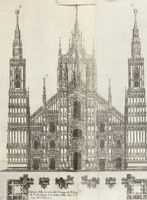
The Milan Cathedral took nearly six centuries to complete and is the largest church in Italy. Built around an older basilica, the Santa Maria Maggiore, the façade remained that of the fifteenth-century building until the beginning of the seventeenth century. This volume is a collection of proposals and designs for the new façade submitted by architects and engineers including Francesco Castelli, Francesco Maria Richini, Carlo Buzzi, and Gian Lorenzo Bernini. Buzzi's plan—with the clever use of flaps in order to display alternate designs—is shown here. It was the basis for the final design completed in 1805. A surprising artifact of the papermaking process lurks in this book—a handprint impressed into the paper fibers! It is likely the vatman's hand, deliberately pressed into the freshly formed sheet in the mould.
-
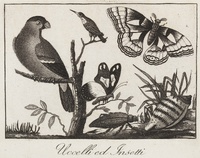
Translated from the French, this manual instructs the amateur on how to paint with watercolors and gouache and contains examples from Annibale Carracci, Rembrandt, and Claude-Joseph Vernet. At the end of the volume are blank palettes with names of colors which the owner could paint in with the correct hues and tints.
-
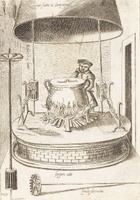
This work combines two of the most important Renaissance books on cooking, service, and etiquette: the monumental Opera dell'arte del cucinare by private chef-to-the-popes Bartolomeo Scappi (circa 1500- 1577) and Vincenzo Cervio's (active 16th century) posthumous treatise on meat carving Il Trinciante (The Carver). Scappi's work was first published in 1570 and was reprinted many times. It is one of the earliest illustrated cookbooks and contains 1,000 recipes, rules for courtly feasts, and even meal plans for papal conclaves. Its illustrations depict Renaissance kitchens and cooking utensils, including the first known picture of a fork. Cervio's work Il Trinciante was finished by fellow carver Fusoritto da Narni and was first published in 1593, along with two of Fusoritto's dialogues, including Il mastro di Casa.
-
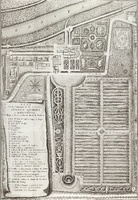
Giustiniana Wynne, later Countess Justine Rosenberg-Orsini, was born in Venice in 1737. A respected author and art historian, she was a prominent member of the pan-European intellectual circle based in Venice. Wynne's early years are better known for a clandestine affair with the son of one of Venice's ruling families, Andrea Memmo; because of their different social classes, they could not marry. She later married Count Rosenberg-Orsini in a secret ceremony. Wynne is also known for an encounter with Casanova and appears in his memoirs. Alticchiero, or Altichiero, is the name of Angelo Querini's villa and gardens on the banks of the river Brenta, near Padua. Querini (1721-1796) was a senator and officer of the Republic of Venice, until his moderate views led to his imprisonment. Upon his release, he retired to Altichiero and created a haven for enlightenment ideas through sculpture, gardens, and landscape architecture. The gardens included an "altar of friendship" and an "altar of the furies" as well as aviaries, labyrinths, and hunting grounds, detailed in the plan shown here.
-
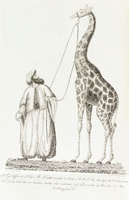
In 1827 Muḥammad ʻAlī Bāshā, Governor of Egypt, sent three giraffes as diplomatic gifts to various European rulers. This giraffe was sent to Francis I, Emperor of Austria, and was in Venice for forty days in 1828, causing a giraffe "craze" before being sent on to the Schönbrunn Palace in Vienna. Animal diplomacy is not uncommon—elephants, rhinoceroses, lions, and more have been gifted for thousands of years—and still happens to this day.
-
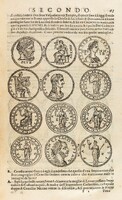
The study of antiquities, especially ancient coins, flourished in the last half of the sixteenth century. Antonio Agustín y Albanell (1517-1596) was archbishop of Tarragona in notheast Spain, jurisconsult, and numismatist. His dialogues, originally written in Spanish, critiqued his contemporaries and their studies for ignorance of the classical Latin sources. Only one hundred copies of his work were printed, as he did not want his opinions on the inferiority of other numismatists to be widely known. He considered himself an artisan and made all of the woodcut illustrations of the various coins, medals, and ruins that appear throughout the work.
-
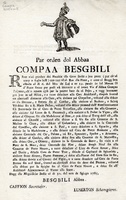
The ephemera shown here is part of a group of notices, announcements, and keepsakes for weddings, balls, festivals, and other courtly activities in the Duchy of Milan in the last half of the eighteenth century. The item above, "Par orden dol abbaa Compaa Besgbili" is in Milanese dialect and relates to a performance by the Fecchin dol Lagh Mejo, or Porters of Lake Maggiore, in this case honoring the arrival of the Count and Countess Castellamare in Milan on July 6, 1785. "Giornale delle feste, che debbonsi fare per le nozze delle LL. AA. RR" lists the festivities celebrating the wedding of Ferdinand, Archduke of Austria, and Maria d'Este for two weeks in October 1771.
























